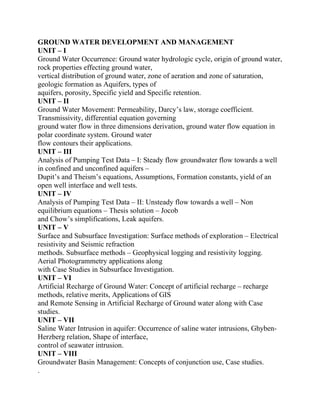4 2
- 1. GROUND WATER DEVELOPMENT AND MANAGEMENT UNIT ŌĆō I Ground Water Occurrence: Ground water hydrologic cycle, origin of ground water, rock properties effecting ground water, vertical distribution of ground water, zone of aeration and zone of saturation, geologic formation as Aquifers, types of aquifers, porosity, Specific yield and Specific retention. UNIT ŌĆō II Ground Water Movement: Permeability, DarcyŌĆÖs law, storage coefficient. Transmissivity, differential equation governing ground water flow in three dimensions derivation, ground water flow equation in polar coordinate system. Ground water flow contours their applications. UNIT ŌĆō III Analysis of Pumping Test Data ŌĆō I: Steady flow groundwater flow towards a well in confined and unconfined aquifers ŌĆō DupitŌĆÖs and TheismŌĆÖs equations, Assumptions, Formation constants, yield of an open well interface and well tests. UNIT ŌĆō IV Analysis of Pumping Test Data ŌĆō II: Unsteady flow towards a well ŌĆō Non equilibrium equations ŌĆō Thesis solution ŌĆō Jocob and ChowŌĆÖs simplifications, Leak aquifers. UNIT ŌĆō V Surface and Subsurface Investigation: Surface methods of exploration ŌĆō Electrical resistivity and Seismic refraction methods. Subsurface methods ŌĆō Geophysical logging and resistivity logging. Aerial Photogrammetry applications along with Case Studies in Subsurface Investigation. UNIT ŌĆō VI Artificial Recharge of Ground Water: Concept of artificial recharge ŌĆō recharge methods, relative merits, Applications of GIS and Remote Sensing in Artificial Recharge of Ground water along with Case studies. UNIT ŌĆō VII Saline Water Intrusion in aquifer: Occurrence of saline water intrusions, Ghyben- Herzberg relation, Shape of interface, control of seawater intrusion. UNIT ŌĆō VIII Groundwater Basin Management: Concepts of conjunction use, Case studies. .
- 2. PAVEMENT ANALYSIS AND DESIGN (ELECTIVE ŌĆōIV) UNIT ŌĆō I Types of pavement ŌĆō Factors affecting design of pavements ŌĆō wheel loads ŌĆōESWL Concept- tyre pressure ŌĆō contact pressure, Material characteristics ŌĆō Environmental and other factors. UNIT ŌĆō II Stresses in flexible pavement ŌĆō layered systems concept ŌĆō one layer system ŌĆō Boussinesq Two layer system ŌĆō Burmister Theory for Pavement Design. UNIT ŌĆō III Stresses in rigid pavements ŌĆō relative stiffness of slab, modulus of sub-grade reaction ŌĆō stresses due to warping, stresses due to loads, stresses due to friction. UNIT ŌĆō IV Pavement design: CBR Method of Flexible Pavement Design- IRC method of flexible pavement design.- AASHO Method of Flexible Pavement design UNIT ŌĆō V IRC method of Rigid pavement design ŌĆō Importance of Joints in Rigid Pavements- Types of Joints ŌĆō Use of Tie Bars and Dowell Bars. UNIT ŌĆō VI Highway Materials ŌĆō Soil, Aggregate and Bitumen- Tests on aggregates ŌĆō Aggregate Properties and their Importance- Tests on Bitumen ŌĆō Bituminous Concrete- Requirements of Design Mix- MarshallŌĆÖs Method of Bituminous Mix design. UNIT ŌĆō VII Highway construction ŌĆō Construction of Earth Roads- Gravel Roads ŌĆō WBM Roads- Bituminous Pavements- Cement Concrete Roads- Steps in Construction- Reinforced Concrete Pavements ŌĆō Soil Stabilization ŌĆō Methods and Objectives- Soil-cement Stabilization and Soil-lime Stabilization. UNIT ŌĆō VIII Need for Highway Maintenance- Pavement Failures- Failures in Flexible Pavements-Types and Causes-Rigid Pavement Failures- Types and causes- Pavement Evaluation- Benkleman Beam method- Strengthening of Existing Pavements- Overlays.
- 3. SOIL DYNAMICS AND MACHINE FOUNDATIONS (ELECTIVE ŌĆōV) UNIT ŌĆō 1 Theory of vibrations: Basic definitions- free and forced vibrations with and without damping for single degree freedom system- Resonance and its effect ŌĆō magnification ŌĆō Logarithmic decrement ŌĆō Transmissibility UNIT ŌĆō II Natural frequency of foundation ŌĆō Soil system: BarkanŌĆÖs and IS methods ŌĆō pressure bulb concept ŌĆō PauwŌĆÖs Analogy. UNIT ŌĆō III Wave propagation: Elastic waves in Rods ŌĆō Waves in elastic Half space. UNIT ŌĆō IV Dynamic Soil Properties: Field and Laboratory methods of determination ŌĆō Uphole, Down hole and cross hole methods ŌĆō Cyclic plate load test ŌĆō Block vibration test ŌĆō Determination of Damping factor. UNIT ŌĆō V Machine Foundations: Types, Design criteria, permissible amplitudes and bearing pressure. UNIT ŌĆō VI Block foundation: Degrees of freedom - analysis under different modes of vibration UNIT ŌĆō VII Analysis of Two Degree freedom systems under free and forced vibrations -Principles of Design of Foundations for reciprocating and impact machines as per IS code. Unit ŌĆō VIII Vibration Isolation: Types and methods ŌĆō Isolating materials and their properties TEXT BOOKS: 1) Handbook of Machine Foundations by P.Srinivasulu and G.V.Vaidyanathan, Tata McGraw Hill 2) Soil Dynamics by Shamsher Prakash



